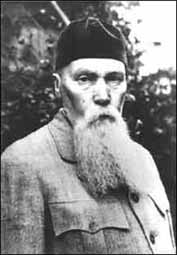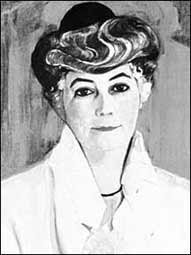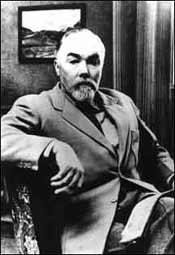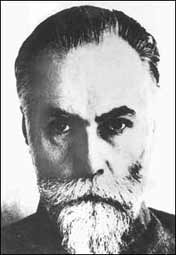BRIEF BIOGRAPHY
OF THE ROERICH FAMILY
 |
Nicholas K. Roerich is a great Russian artist, writer, archeologist, philosopher, traveller and a public figure. He was born in St.Petersburg on 9th of October, 1874. In 1897 he graduated from the Academy of Arts. In 1898 - Nicholas Roerich graduated from the law faculty of the St.Petersburg University. At his student years Roerich had already been admitted as a member to the Russian Archeological Society. Since 1901 Roerich was a Secretary of the Society of Arts Encouragement. And since 1906 he was a Director of an art school. In 1909 Nicholas Roerich became an Academician of the Russian Academy of Arts. Since 1910 he was at the head of the art union “Mir Iskusstva” (”The World of Art”). In the years of 1900-1910 Roerich was one of the founders and the most active figures of the Society of Renascence of the art Russia and the Society of Protection and Preservation of the Monuments of Art and Past in Russia. In 1920-1922 in the USA Nicholas Roerich established the Institute of the United Arts in New York and other cultural and educative unions. In 1923 the Museum of Roerich was opened in New York. It was the first museum of a Russian artist abroad. In 1924-1928 Roerich undertook a scientific and art expedition through the Himalayas, Tibet, Mongolia and in 1934-1935 — around Manchuria and China. In 1928 in India he established the International Institute of the Himalayan Studies “Urusvati”. In 1942 upon the initiative of Nicholas Roerich the American-Russian Cultural Association was established in New York and he was chosen as its honorary President. In 1945 Roerich began the preparations to return to his motherland but on the eve of departure, December 13, 1947, he left the earthly plane.
 |
Helen I. Roerich was born in St.Petersburg on 12th of February, 1897. It was a nobiliary family distinguished not only for its nobility but for its cultural traditions too. On the maternal line her great-grandfather was the great Russian general Mikhail Kutuzov. Among her relatives there were a composer Modest Musorgsky and a poet Arseniy Golenishchev-Kutuzov. Already in her early age — during her studying with teachers of the St.Petersburg Conservatory — Helen showed an outstanding talent for music. As a pianist she performed solo concerts. In 1901 Helen married Nicholas Roerich. Since that time they were inseparable on life and spiritual-creative paths. She became his companion-in-arms in all his public and cultural undertakings. Together with her husband Helen Roerich participated in the heroical transhimalayan expedition. After the Roerich family settled in Kullu valley in Himalayas, there was established the Himalayan Institute of the Scientific Studies and its honorary president — the foundress was Helen Roerich. The years of life in India were the time of the most intensive work of Helen. Here she completed a major part of books of Agni Yoga series (the Living Ethics). There were published 14 volumes of that series. On title pages of the volumes there is no name of the author, since Helen Roerich considered that the sacred wisdom stated there can not be the author’s property. She considered herself an author of three books only. They were published under different pen-names: “The Foundations of Buddhism” (1927), “The Cryptograms of the East” (1929), “The Banner of the Reverent Sergius” (1934). Besides, she maintained very active correspondence with many people from Europe, Asia and America. Two volumes of her letters were published in Riga in 1940. Helen Roerich also did the translations. She translated into Russian the extracts from the book “The Letters of the Mahatmas to Sinnet” (”The Chalice of the East”) and also two volumes of “The Secret Doctrine” by Helen Blavatsky. After death of her husband Helen Roerich moved to Kalimpong. Here on 5th of October, 1955, she finished her earthly days.
 |
George N. Roerich (Yuriy N. Roerich: 16.08.1902.-21.05.1960) is an outstanding Russian orientalist, philologist, art critic, ethnographer, traveller. He contributed very much to the world Tibetology, Indology and Mongology, He was born in a village Okulovka of Novgorod province. His child’s and adolescent years passed in St. Petersburg. Already at his school years George Roerich showed a serious interest for the Orient. In 1919 he graduated from the Indo-Iranian department of the School of oriental languages at the University of London. And then in 1922 he graduated from the Harvard University in the USA, the department of Indian philology, with a bachelor’s degree. G. Roerich completed his education in 1923 in France at the School of oriental languages of the University of Paris (the biggest center of the European oriental studies), where he received a title of Master of the Indian philology. In 1923-1928 he participated in the Central-Asian expedition organized by his father N. Roerich. Since 1928 and until the beginning of the Second World War George Roerich was a director of the Himalayan Institute of the Scientific Studies “Urusvati”, the work of which was directed towards complex studies of the Orient. In the sphere of public activity he participated in propaganda and struggle for the ratification of the Pact of Roerich. In 1949-1957 he taught at the University of Kalimpong (India). In autumn 1957 he returned to the Motherland and headed the sector of Indian history of religion and philosophy at the Institute of the Oriental Studies of the Academy of Science of the USSR in Moscow. It is George Roerich to whom belongs the invaluable service of “returning” to the Motherland of the art heritage of his father — the great Russian Artist, thinker and a public figure — Nicholas Roerich. On May 21, 1960, George Roerich finished his earthly path in Moscow.
 |
Svyatoslav N. Roerich was born on October 23, 1904, in St.Petersburg. In 1914-1916 he studied at the school of K. May. At that school Svyatoslav received his first lessons of drawing. His father often took him to the archeological trips around ancient Russian cities. There Svyatoslav studied history and culture of Russia. He continued his painting lessons and also participated in creation of decorations for operas “Snow-Maiden”, “Sadko”, “Prince Igor” together with his father. Since 1920 he lived in the United States. Svyatoslav Roerich entered the Columbia University, the department of architecture, which he graduated with a bachelor's degree. At that time Svyatoslav painted many pictures, book illustrations and drawings. Since 1923 S. Roerich was a director of the International Center of Art “Korona Mundi” in New York, which was founded by his father Nicholas K. Roerich. In 1928 Svyatoslav moved from the USA to India (Darjeeling) to his family. Having perceived creatively many art ideas and convictions of his father, Svyatoslav Roerich became a distinctive and original artist. Studying the culture, art and philosophy of India he created many wonderful paintings. Together with landscapes he painted many portraits. The portraits of N. Roerich, prime-minister of India J. Neru and Devika Rani — Svyatoslav Roerich’s wife, must be specially marked. One of the most beautiful ones is a portrait of his mother Helen I. Roerich, the woman of exceptional spiritual and physical beauty. Svyatoslav Roerich headed the department of folk art and pharmacopoeia at the Institute “Urusvati”. He did a lot of enlightening work, directed the Art School in Bangalore, held his personal exhibitions. In 1989 upon the initiative of Svyatoslav Roerich in the USSR there was established the Soviet Foundation of the Roerichs, at the base of which there were laid studies and spreading of the ideas of the Roerichs family. In 1991 Svyatoslav Roerich granted the Soviet Foundation of the Roerichs with the archives of his parents and his brother, which were kept in India before. On January 30, 1993, Svyatoslav Roerich finished his earthly path in Bangalore (South India).
